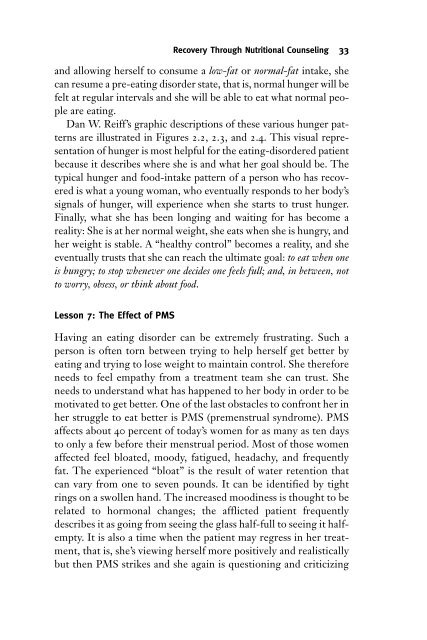Eating Disorders - fieldi
Eating Disorders - fieldi
Eating Disorders - fieldi
You also want an ePaper? Increase the reach of your titles
YUMPU automatically turns print PDFs into web optimized ePapers that Google loves.
and allowing herself to consume a low-fat or normal-fat intake, she<br />
can resume a pre-eating disorder state, that is, normal hunger will be<br />
felt at regular intervals and she will be able to eat what normal people<br />
are eating.<br />
Dan W. Reiff’s graphic descriptions of these various hunger patterns<br />
are illustrated in Figures 2.2, 2.3, and 2.4. This visual representation<br />
of hunger is most helpful for the eating-disordered patient<br />
because it describes where she is and what her goal should be. The<br />
typical hunger and food-intake pattern of a person who has recovered<br />
is what a young woman, who eventually responds to her body’s<br />
signals of hunger, will experience when she starts to trust hunger.<br />
Finally, what she has been longing and waiting for has become a<br />
reality: She is at her normal weight, she eats when she is hungry, and<br />
her weight is stable. A “healthy control” becomes a reality, and she<br />
eventually trusts that she can reach the ultimate goal: to eat when one<br />
is hungry; to stop whenever one decides one feels full; and, in between, not<br />
to worry, obsess, or think about food.<br />
Lesson 7: The Effect of PMS<br />
Recovery Through Nutritional Counseling 33<br />
Having an eating disorder can be extremely frustrating. Such a<br />
person is often torn between trying to help herself get better by<br />
eating and trying to lose weight to maintain control. She therefore<br />
needs to feel empathy from a treatment team she can trust. She<br />
needs to understand what has happened to her body in order to be<br />
motivated to get better. One of the last obstacles to confront her in<br />
her struggle to eat better is PMS (premenstrual syndrome). PMS<br />
affects about 40 percent of today’s women for as many as ten days<br />
to only a few before their menstrual period. Most of those women<br />
affected feel bloated, moody, fatigued, headachy, and frequently<br />
fat. The experienced “bloat” is the result of water retention that<br />
can vary from one to seven pounds. It can be identified by tight<br />
rings on a swollen hand. The increased moodiness is thought to be<br />
related to hormonal changes; the afflicted patient frequently<br />
describes it as going from seeing the glass half-full to seeing it halfempty.<br />
It is also a time when the patient may regress in her treatment,<br />
that is, she’s viewing herself more positively and realistically<br />
but then PMS strikes and she again is questioning and criticizing









